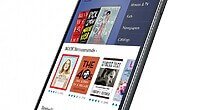
The Tolino Vision is the latest e-reader to hit the market and packs a serious punch in the hardware department. Kobo and Tolino are both vying for a piece of the lucrative German eBook market. How does the Vision compare against the Aura in terms of performance, ecosystem and software? Today, we look at the two side by side in a battery of tests.
The Kobo Aura maintains the standard six-inch approach that the company made famous with their entire product line. It currently has a super high resolution e-Ink “Clarity Screen” with 1024 x 758 and 212 DPI. It is powered by the quintessential Freescale i.MX507 1 GHZ processor and has 1 GB of RAM. There are 4 GB of internal memory, which can be enhanced via the Micro SD Card.
The Tolino Vision features the latest in e-Paper innovation, e Ink Carta. This is the exact screen technology found on the Kindle Paperwhite 2. This will not only provide higher contrast, but also eliminate the refreshing when you turn a page in an eBook. The overall resolution is a very respectable 1024 × 758 pixels. One of the things that stands out with this model is that the screen is flush with the bezel. The only other e-reader to do this was the six inch Kobo Aura, it almost feels like a tablet or smartphone in this respect. Underneath the hood is a Freescale iMx6 1 GHz processor and 512 MB RAM. There is 4GB of internal memory, which can be expanded via the Micro SD.
The Vision gives a better visual eBook experience and has solid options to customize your font, line spacing, margins and alignment. Kobo gives better font augmentation options via their sliders, which has millions of different combinations. One advantage Kobo has over the Vision is the ability for users to load in their own fonts.
The Aura wins in the PDF department with their advanced rendering engine. You get a visual indictor on the top left hand corner of where you are in the document if you zoom in. You can also pinch and zoom which is very useful. The Vision has no pinch and zoom functionality and has to be double tapped to enter a full screen zoom. There is huge bugs with the rendering of PDF files on the Vision, as demonstrated in the video.
Overall the Vision is designed better and employs bleeding edge e-paper technology. If you are buying it just to read German eBooks you won’t be let down. The Aura wins out if you are looking for a more complete package device that will appeal to advanced users.
Michael Kozlowski is the editor-in-chief at Good e-Reader and has written about audiobooks and e-readers for the past fifteen years. Newspapers and websites such as the CBC, CNET, Engadget, Huffington Post and the New York Times have picked up his articles. He Lives in Vancouver, British Columbia, Canada.
